Discover 20 hidden attractions, cool sights, and unusual things to do in North Little Rock (United States). Don't miss out on these must-see attractions: Dickey-Stephens Park, T. R. Pugh Memorial Park, and Crestview Park. Also, be sure to include Lakewood Park in your itinerary.
Below, you can find the list of the most amazing places you should visit in North Little Rock (Arkansas).
Table of Contents
Dickey-Stephens Park

Ballpark in North Little Rock, Arkansas. Dickey–Stephens Park is a baseball park in North Little Rock, Arkansas, United States. The ballpark is primarily used for baseball and serves as the home for the Arkansas Travelers of the Texas League. The capacity of the ballpark is 7,200 which includes 5,800 fixed seats capacity and 1,500 on the berms. It opened in 2007 as a replacement for Ray Winder Field in Little Rock, Arkansas. The ballpark is named after four local Arkansas brothers: Baseball Hall of Famer Bill Dickey, former Major League Baseball catcher George Dickey, and businessmen Jackson T. Stephens and W. R. Stephens.[1]
Address: 400 W Broadway St, 72114-5522 North Little Rock
T. R. Pugh Memorial Park
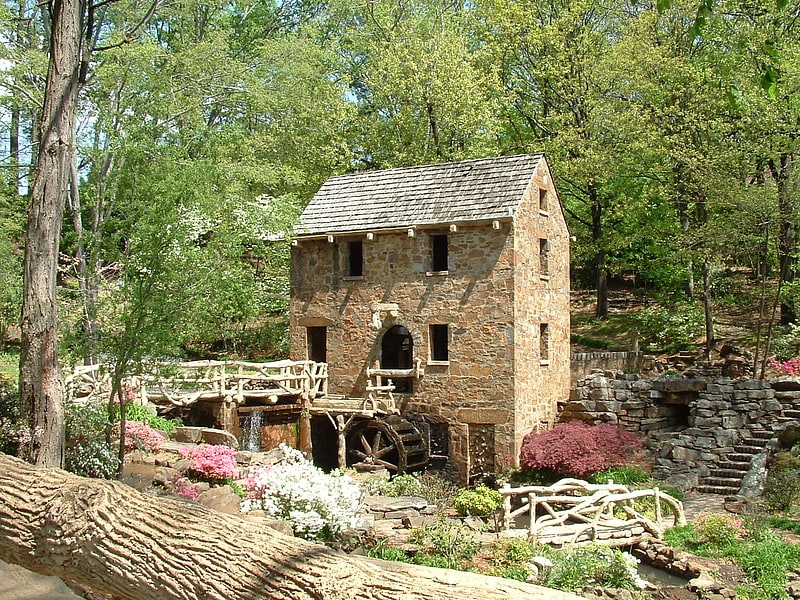
Park in North Little Rock, Arkansas. T. R. Pugh Memorial Park is a re-creation of an 1880s era water-powered grist mill located in North Little Rock, Arkansas. It was used in the opening scenes of the movie classic Gone With The Wind. In 2010, the site was listed on the National Register of Historic Places.
The park was built in 1933 by Justin Matthews and named in honor of Thomas R. Pugh, of Portland, Arkansas, who was a close friend and benefactor of Matthews. The architect for the park and the mill was Frank Carmean with artist Dionicio Rodriguez serving as sculptor of the concrete work to simulate wooden, iron, and steel structures.
In present day, due to its picturesque views, the Old Mill serves as the backdrop for weddings and portrait photography.
In 2008, the roof was set on fire, but no permanent damage resulted.[2]
Address: 3800 Lakeshore Dr, 72116 North Little Rock
Crestview Park
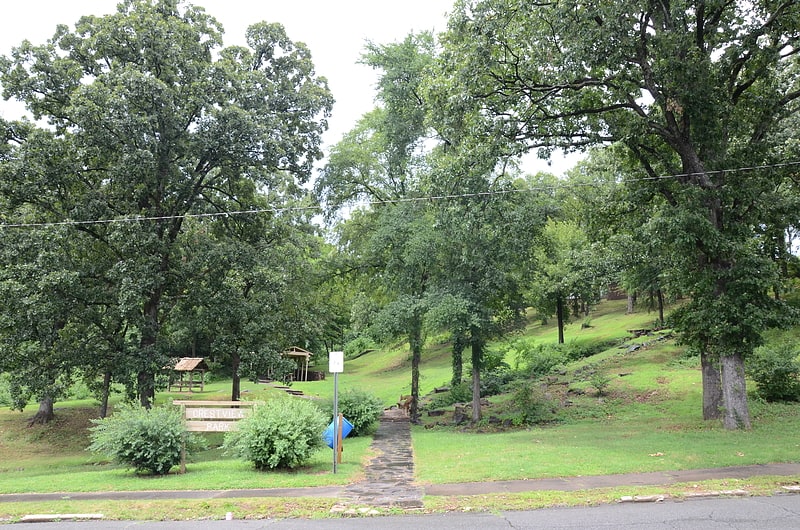
Park in North Little Rock, Arkansas. Crestview Park is a small neighborhood park in North Little Rock, Arkansas. It is roughly bounded by Cherry Hill Drive, Crestview Drive, and the westbound onramp to Interstate 40 from Arkansas Highway 107. The park, set on a steeply sloping parcel, has no major amenities, and was established for passive recreational uses of the nearby population. The park is notable for the presence of two naturalistic sculptures by Dionicio Rodriguez that were installed c. 1933. One is a footbridge that appears to have been fashioned out of a fallen tree, and the other is rustic shelter, one of Rodriguez' more unusual works.
The artwork within the park was listed on the National Register of Historic Places in 1986.[3]
Lakewood Park

Association in North Little Rock, Arkansas. Lakewood Park is a private park located at the northern end of Lake Number Three in North Little Rock, Arkansas. It is roughly bounded on the east by Edgemere Drive, the south by the lake, and the west by Lakeshore Drive, although a portion of the park lies west of Lakeshore Drive. Use of most of the park's athletic and recreational facilities are limited to members of the Lakewood Property Owners Association, which owns and manages the park. The park includes seven artworks by the Mexican artist Dionicio Rodriguez, which are listed on the National Register of Historic Places.[4]
Address: 4500 Lakeshore Dr, North Little Rock
North Little Rock City Hall
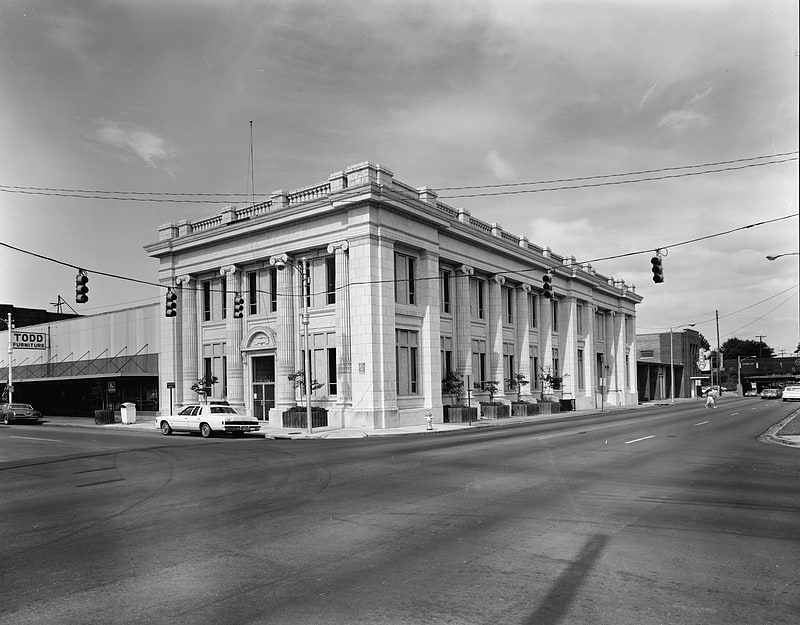
Building in Little Rock, Arkansas. North Little Rock City Hall is located at 300 Main Street in North Little Rock, Arkansas. It is a Classical Revival two-story building, with an exterior of stone with terra cotta trim. Prominent features of its street-facing facades are massive engaged two-story fluted Ionic columns. It was built in 1914–15, and is based on the design of a bank building seen by Mayor J.P. Faucette in St. Louis, Missouri.
The building was listed on the National Register of Historic Places in 1975. It is located in the city’s Argenta Historic District.[5]
First Presbyterian Church Manse
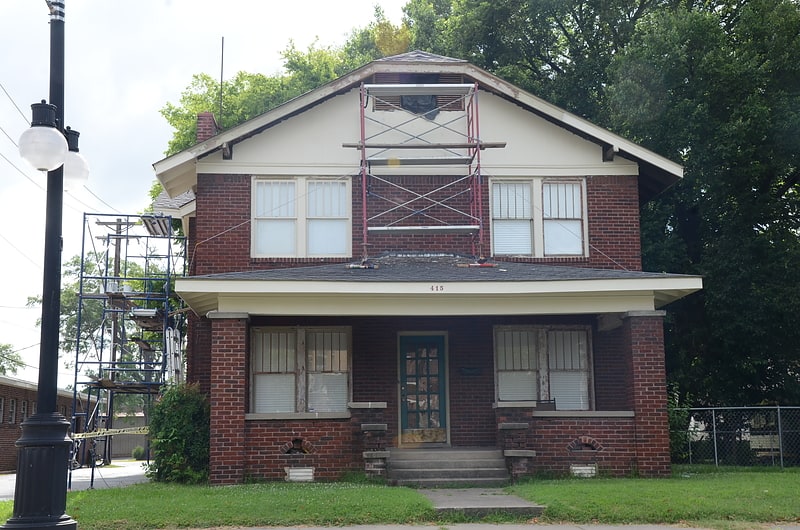
The First Presbyterian Church Manse is a historic church parsonage at 415 North Maple Street in North Little Rock, Arkansas. It is a two-story brick-faced structure, with a clipped-gable roof that has wide eaves with Craftsman-style exposed rafter ends and large brackets. A porch extends across the front facade, supported at the ends by brick piers, with a low brick balustrade on either side of the entry stairs. The house was built in 1927 as the official residence of the North Little Rock First Presbyterian Church's pastor. It was used to house ministers until the 1960s, and has since served a variety of functions, including youth center and law office.
The building was listed on the National Register of Historic Places in 1993.[6]
Lake No. 1 Bridge

Bridge in North Little Rock, Arkansas. The Lake No. 1 Bridge is a historic bridge carrying Avondale Road across the northern tip of Lake Number 1 in North Little Rock, Arkansas. It is a closed-spandrel stone arch bridge with Rustic styling, built in the 1920s as part of the Lakewood development promoted by developer Justin Mathews. It has a single elliptical arch, spanning 18 feet, with a total structure length of 30 feet. It was one of eight stone arch bridges built in the state between 1923 and 1939, and one of the few that was privately built.
The bridge was listed on the National Register of Historic Places in 1990.[7]
Waterside Street Bridge
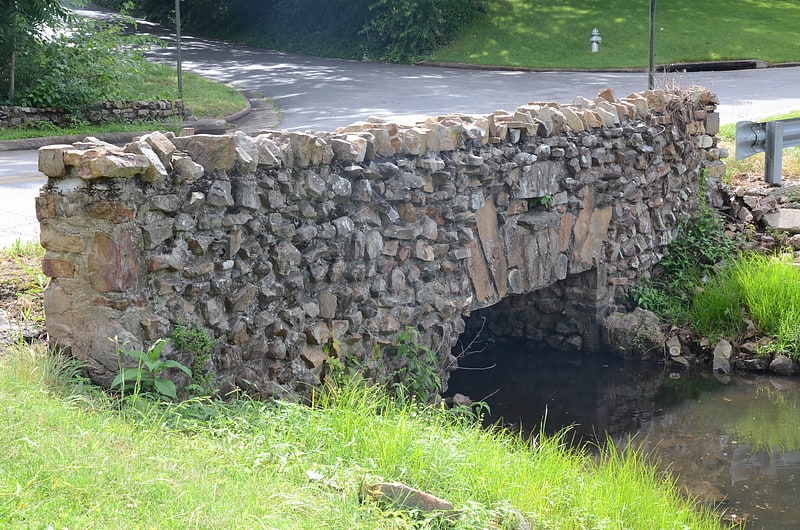
Bridge. The Waterside Street Bridge is a historic bridge, carrying Waterside Street across an inlet of Lake Number 1 in North Little Rock, Arkansas. It is a rustic closed-spandrel masonry structure, with an exterior of rough uncoursed fieldstone that rises to parapet above the side of the roadbed. It is one of four masonry bridges built between 1929 and 1939 by developer Justin Matthews as part of the Lakewood subdivision.
The bridge was listed on the National Register of Historic Places in 1990.[8]
St. Joseph's Home
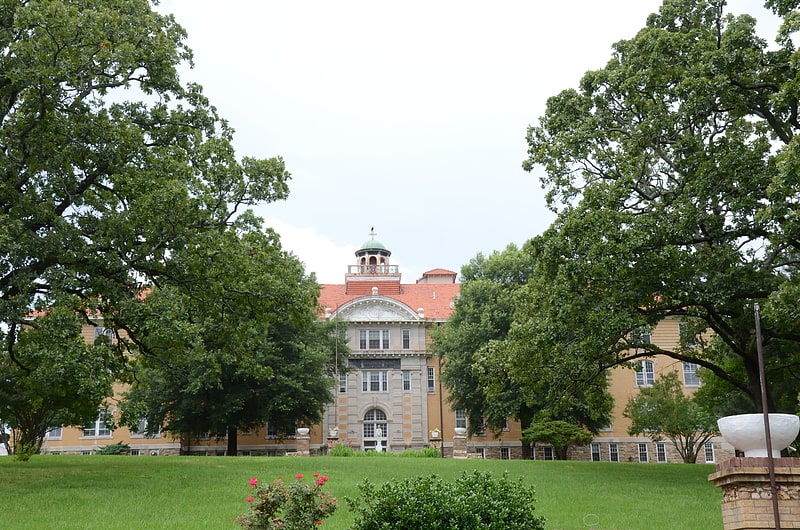
St. Joseph's Home is a historic Roman Catholic orphanage on Camp Robinson Road in North Little Rock, Arkansas. It is a large three-story brick building, with a tile hip roof and a stone foundation. The roof is topped by a cupola with a cross as a spire. The building is roughly H-shaped, with projecting wings on either side of central section. It has eighty bedrooms. It was built in 1910 by the Roman Catholic Diocese of Little Rock.
The facility was listed on the National Register of Historic Places in 1976.[9]
Address: 6800 Camp Robinson Rd, North Little Rock
Argenta Branch Library
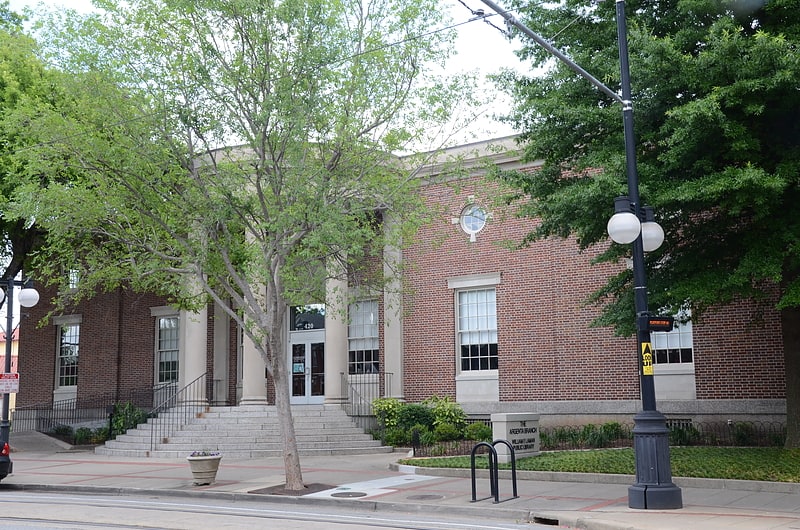
Public library in North Little Rock, Arkansas. The Argenta Branch Library is a branch of the North Little Rock Public Library System in North Little Rock, Arkansas, United States. The building is a brick Georgian Revival constructed in 1931 to a design by Arkansas architect Charles L. Thompson. It was used as a post office until 2011, and was opened as a branch library in 2014.
The building was added to the National Register of Historic Places in 1982.[10]
Address: 506 Main St, 72114 North Little Rock
Owings House
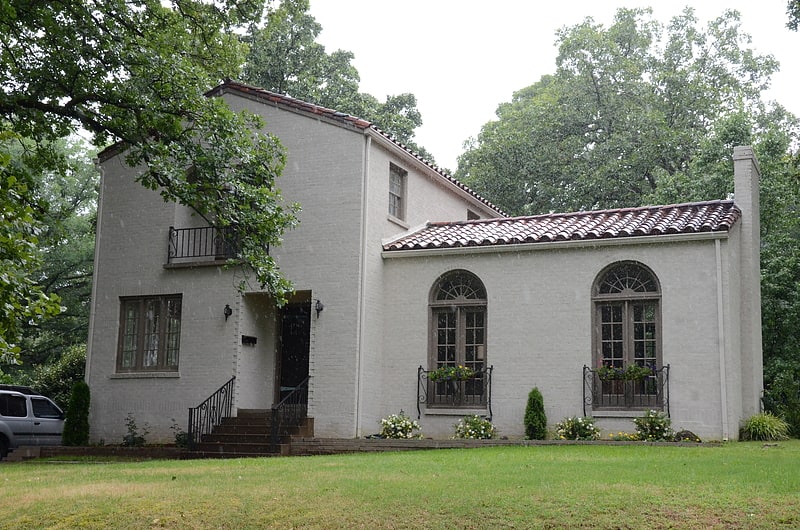
Building. The Owings House is a historic house at 563 Skyline Drive in North Little Rock, Arkansas. It is a two-story brick building, with classic Spanish Revival features, including a tile roof, arched openings, and iron grillwork. It is unusual in that its brick has not been stuccoed. The house was built in 1927 by Justin Matthews as part of his large Edgemont development. It was the first house to be completed, and was lost by its owners to foreclosure during the Great Depression.
The house was listed on the National Register of Historic Places in 1992.[11]
East End Methodist Episcopal Church
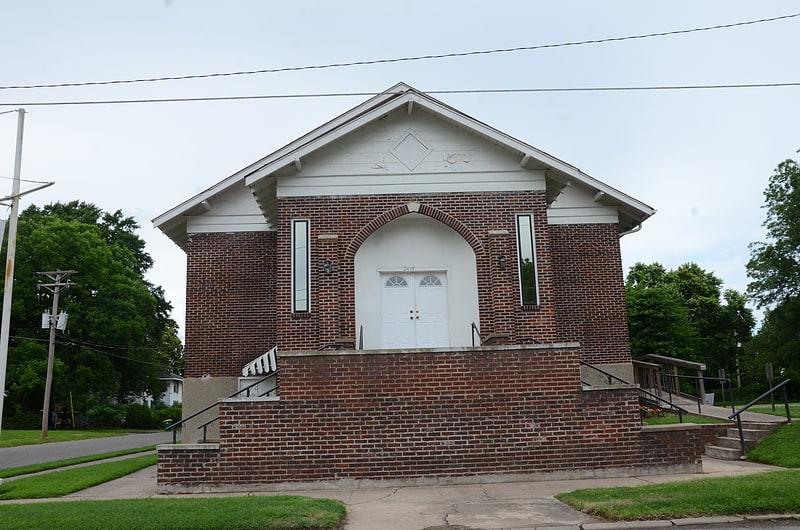
Church in North Little Rock, Arkansas. The East End Methodist Episcopal Church is a historic church at 2401 E. Washington Avenue in North Little Rock, Arkansas. It is a single-story brick structure, with a broad gable roof and a porch extending across part of its front facade. It was built in 1922 for a congregation founded in 1915, and is a fine local example of vernacular Craftsman architecture.
The building was listed on the National Register of Historic Places in 2008.[12]
Pyeatte-Mason Cemetery

Cemetery in Maumelle, Arkansas. The Pyeatte-Mason Cemetery is a small historic cemetery at the junction of Waterside and Lily Streets on the west side of Maumelle, Arkansas. It occupies a small wooded lot, and has ten marked graves. It contains graves of some of Pulaski County's earliest settlers, the Pyeatte and Carnahan families. They settled this area in 1812, calling it Crystal Hill. The only dated graves in the cemetery are marked 1818 and 1883. They were led by the brothers James Pyeatt, a farmer, and Jacob Pyeatt, who operated a ferry on the Arkansas River. The first Protestant services held in Arkansas were conducted in 1812 in the home of James Pyeatt by the Reverend John Carnahan of the Cumberland Presbyterian Church. The original settlement, called Pyeattstown, grew to 150 people by 1819. Pyeatte township was formed in 1823. James Pyeatt died in 1833 and was buried near his land in a small cemetery that is now near the Maumelle Country Club's golf course. The township of Maumelle was formed in 1842. It was composed of two sections: Little Maumelle and Big Maumelle.
The cemetery was listed on the National Register of Historic Places in 1996.[13]
Barth-Hempfling House
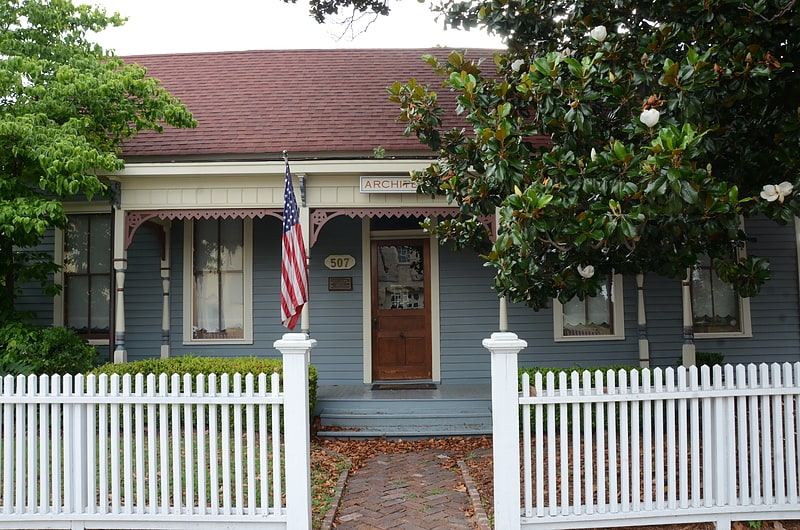
The Barth-Hempfling House is a historic house at 507 Main Street in North Little Rock, Arkansas. It is a single-story wood-frame structure, five bays wide, with a side gable roof and vernacular Late Victorian styling. It was built in 1886 for German immigrants, and is the last surviving house on Main Street in downtown North Little Rock, an area that was once lined with similar houses.
The house was listed on the National Register of Historic Places in 1986. It is also a contributing element of the Argenta Historic District.[14]
Lakeshore Drive Bridge
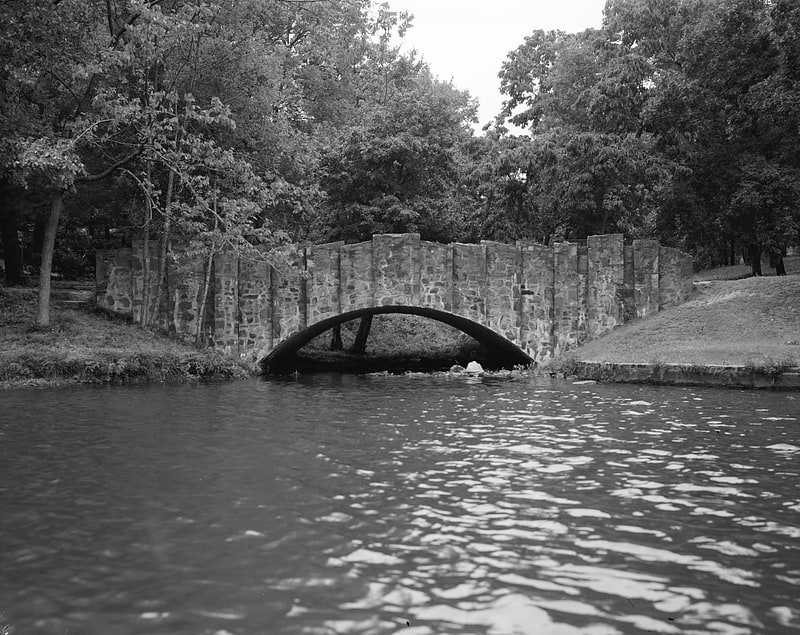
Bridge in North Little Rock, Arkansas. The Lakeshore Drive Bridge carries a closed-off portion of Lakeshore Drive across a tributary stream on the west side of Lake Number 3 in North Little Rock, Arkansas. It is a stone arch bridge with closed spandrels and a total structure length of 53 feet. The bridge consists of a single elliptical curved arch, which spans 20 feet and is 5 feet high. Rustic square stone columns rise from the spandrels, creating uneven parapets on the sides of the structure. The bridge was built in the late 1930s as part of developer Justin Matthews' construction of the Lakewood area. It is one of a small number of documented masonry arch bridges in the state.
The bridge was listed on the National Register of Historic Places in 1990.[15]
Edgemere Street Bridge
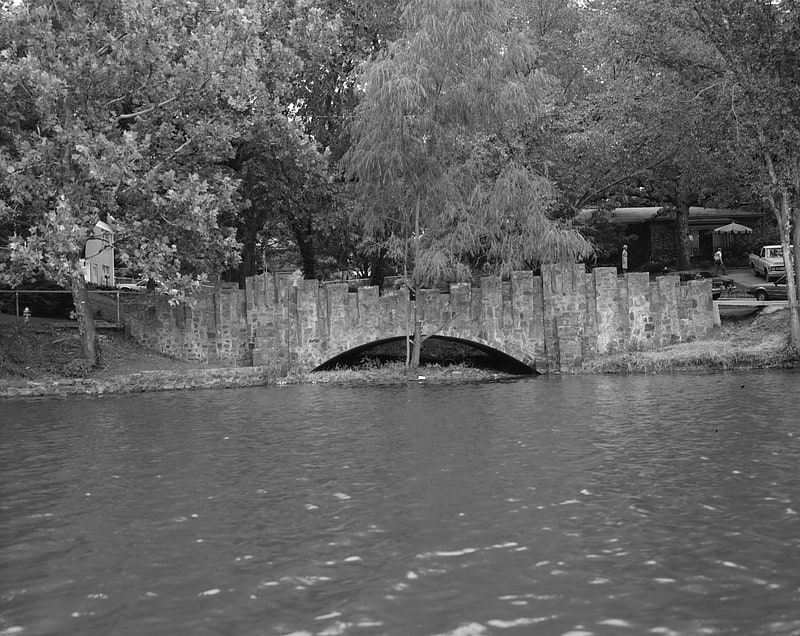
Bridge in North Little Rock. The Edgemere Street Bridge is a historic bridge in North Little Rock, Arkansas. It carries Edgemere Street over a small part of Lakewood Lake Number Three. It is a masonry structure with closed spandrels, and has a span of about 18 feet and a total length of 57 feet. It is built out of rustic, roughly squared fieldstone, that is laid in uncoursed fashion. Vertical columns project from either side of the spandrels, rising above the deck level to form a decorative parapet. It was built, along with the similar Lakeshore Drive Bridge as part of the innovative Lakewood Development project of developer Justin Matthews in the 1930s.
The bridge was listed on the National Register of Historic Places in 1990.[16]
Cherry House
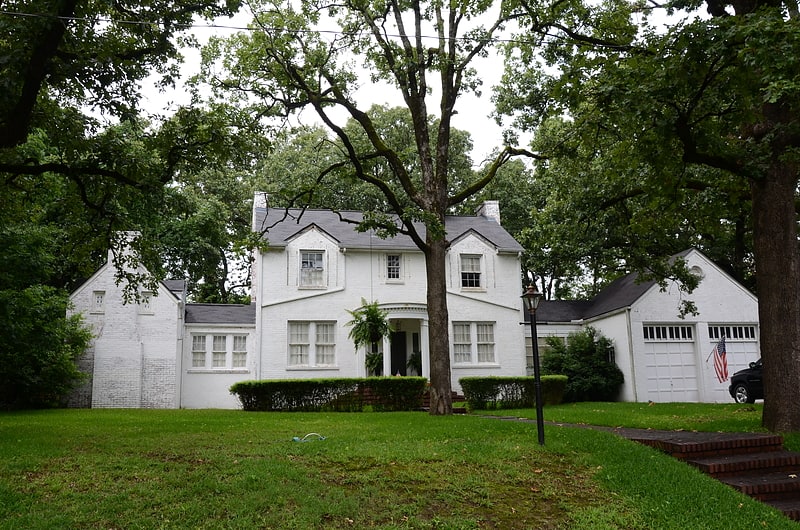
The Cherry House is a historic house at 217 Dooley Road in North Little Rock, Arkansas. It is a 2+1⁄2-story wood-frame structure, finished with a painted brick veneer. The main block has single-story flanking wings, which join it to a two-story wing on the left and a garage on the right. The main entrance is sheltered by a Georgian Revival-style semicircular portico. Built in 1930, it has been asserted to be the finest example of Colonial Revival architecture in the city's Edgemont neighborhood.
The house was listed on the National Register of Historic Places in 1992.[17]
Justin Matthews Jr. House
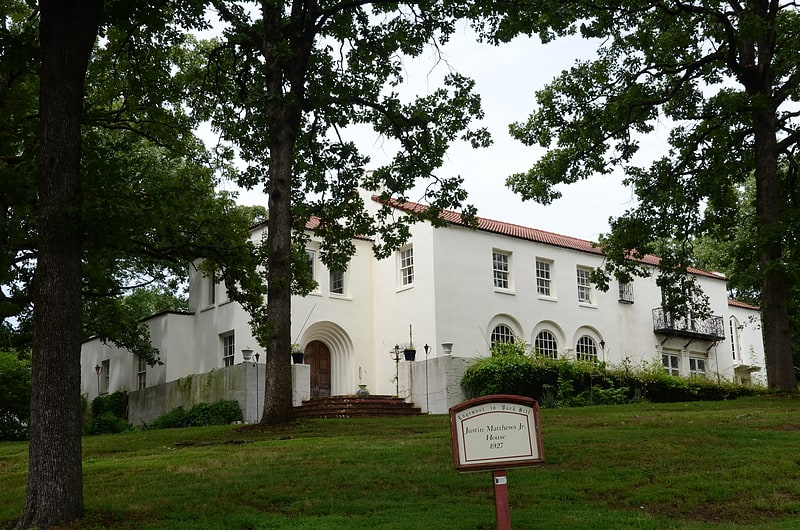
The Justin Matthews Jr. House is a historic house at 257 Skyline Drive in North Little Rock, Arkansas. It is a large two story Mediterranean Revival house, designed by Little Rock architect Max F. Meyer and built in 1928. It has all of the hallmarks of this style, including a red tile roof, stuccoed walls, arched openings for doors and windows, and wrought iron grillwork. The house was built for the son of developer Justin Matthews in his Park Hill development.
The house was listed on the National Register of Historic Places in 1990.[18]
Engelberger House
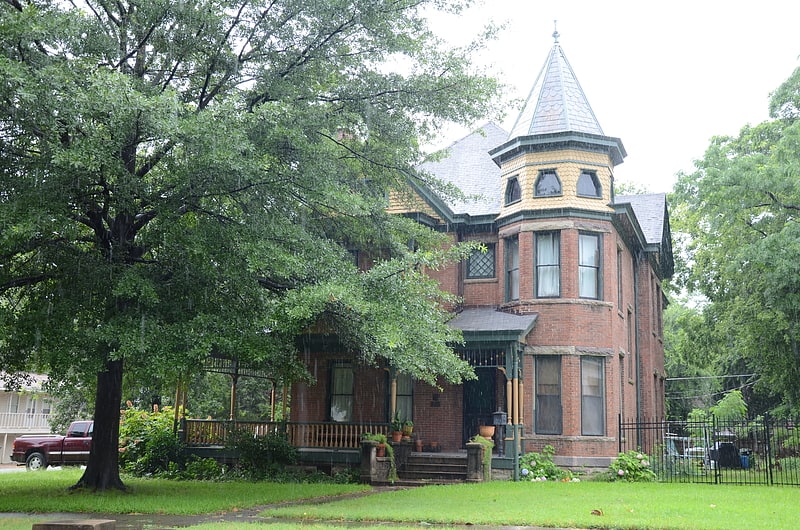
The Engelberger House is a historic house at 2105 North Maple Street in North Little Rock, Arkansas. It is a two-story wood-frame structure, with a hip roof and asymmetrical massing characteristic of the Queen Anne style of architecture. It has several projecting gable sections, an octagonal tower at one corner, and a porch that wraps around two sides. It was built in 1895 by Alonzo "Lonnie" Clayton, an African American jockey and the youngest to win the Kentucky Derby. Lonnie was 15 years old when he won the Kentucky Derby in 1892. The Engelberger House is one of only two high-style Queen Anne houses in the city.
The house was listed on the National Register of Historic Places in 1990.[19]
Bailey Allinder House
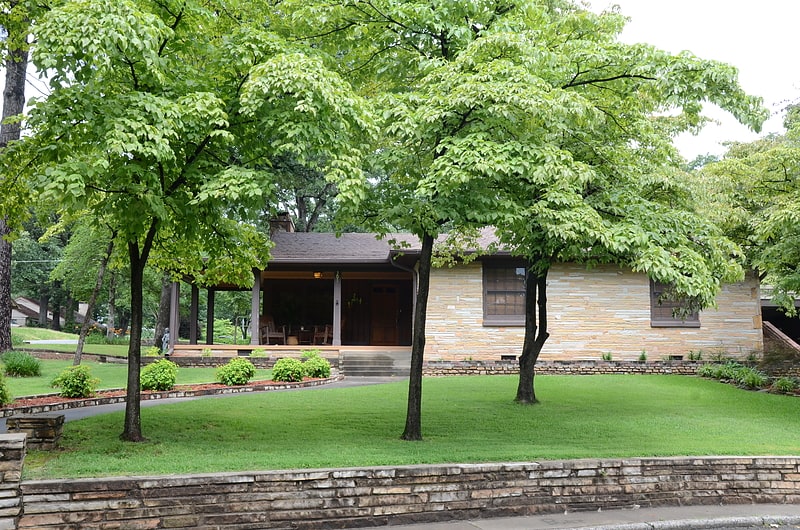
The Bailey Allinder House is a historic house located at 301 Skyline Drive in the Park Hill neighborhood of North Little Rock, Arkansas. It is representative of the transition from the Minimal Traditional style to the Ranch style form, yet it also reflects subtle Rustic influences reminiscent of Frank Lloyd Wright's incorporation of natural materials and setting in the design of his work.[20]